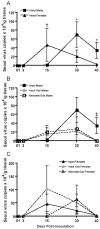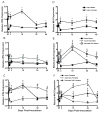Sex differences in the recognition of and innate antiviral responses to Seoul virus in Norway rats
- PMID: 18053684
- PMCID: PMC2396444
- DOI: 10.1016/j.bbi.2007.10.005
Sex differences in the recognition of and innate antiviral responses to Seoul virus in Norway rats
Abstract
Among rodents that carry hantaviruses, more males are infected than females. Male rats also have elevated copies of Seoul virus RNA and reduced transcription of immune-related genes in the lungs than females. To further characterize sex differences in antiviral defenses and whether these differences are mediated by gonadal hormones, we examined viral RNA in the lungs, virus shedding in saliva, and antiviral defenses among male and female rats that were intact, gonadectomized neonatally, or gonadectomized in adulthood. Following inoculation with Seoul virus, high amounts viral RNA persisted longer in lungs from intact males than intact females. Removal of the gonads in males reduced the amount of viral RNA to levels comparable with intact females at 40 days post-inoculation (p.i.). Intact males shed more virus in saliva than intact females 15 days p.i.; removal of the gonads during either the neonatal period or in adulthood increased virus shedding in females and decreased virus shedding in males. Induction of pattern recognition receptors (PRRs; Tlr7 and Rig-I), expression of antiviral genes (Myd88, Visa, Jun, Irf7, Ifnbeta, Ifnar1, Jak2, Stat3, and Mx2), and production of Mx protein was elevated in the lungs of intact females compared with intact males. Gonadectomy had more robust effects on the induction of PRRs than on downstream IFNbeta or Mx2 expression. Putative androgen and estrogen response elements are present in the promoters of several of these antiviral genes, suggesting the propensity for sex steroids to directly affect dimorphic antiviral responses against Seoul virus infection.
Figures






Similar articles
-
Neonatal sex steroids affect responses to Seoul virus infection in male but not female Norway rats.Brain Behav Immun. 2002 Dec;16(6):736-46. doi: 10.1016/s0889-1591(02)00026-0. Brain Behav Immun. 2002. PMID: 12480503
-
Differential expression of immunoregulatory genes in male and female Norway rats following infection with Seoul virus.J Med Virol. 2004 Sep;74(1):180-90. doi: 10.1002/jmv.20163. J Med Virol. 2004. PMID: 15258986
-
Corticosteroids modulate Seoul virus infection, regulatory T-cell responses and matrix metalloprotease 9 expression in male, but not female, Norway rats.J Gen Virol. 2008 Nov;89(Pt 11):2723-2730. doi: 10.1099/vir.0.2008/03715-0. J Gen Virol. 2008. PMID: 18931068 Free PMC article.
-
Seoul virus enhances regulatory and reduces proinflammatory responses in male Norway rats.J Med Virol. 2008 Jul;80(7):1308-18. doi: 10.1002/jmv.21213. J Med Virol. 2008. PMID: 18461618 Free PMC article.
-
Social status does not predict responses to Seoul virus infection or reproductive success among male Norway rats.Brain Behav Immun. 2006 Mar;20(2):182-90. doi: 10.1016/j.bbi.2005.06.003. Epub 2005 Jul 22. Brain Behav Immun. 2006. PMID: 16040226 Free PMC article.
Cited by
-
Molecular detection and genomic characterization of Samak Micromys paramyxovirus-1 and -2 in Micromys minutus, Republic of Korea.Virol J. 2024 Oct 15;21(1):255. doi: 10.1186/s12985-024-02532-6. Virol J. 2024. PMID: 39407289 Free PMC article.
-
High-fat and High-sucrose Diet-induced Hypothalamic Inflammation Shows Sex Specific Features in Mice.Neurochem Res. 2024 Dec;49(12):3356-3366. doi: 10.1007/s11064-024-04243-4. Epub 2024 Sep 20. Neurochem Res. 2024. PMID: 39302596 Free PMC article.
-
Bacteriophages-Dangerous Viruses Acting Incognito or Underestimated Saviors in the Fight against Bacteria?Int J Mol Sci. 2024 Feb 9;25(4):2107. doi: 10.3390/ijms25042107. Int J Mol Sci. 2024. PMID: 38396784 Free PMC article. Review.
-
Disparate macrophage responses are linked to infection outcome of Hantan virus in humans or rodents.Nat Commun. 2024 Jan 10;15(1):438. doi: 10.1038/s41467-024-44687-4. Nat Commun. 2024. PMID: 38200007 Free PMC article.
-
The Role of Lipids in the Regulation of Immune Responses.Nutrients. 2023 Sep 7;15(18):3899. doi: 10.3390/nu15183899. Nutrients. 2023. PMID: 37764683 Free PMC article. Review.
References
-
- Arnold AP, Breedlove SM. Organizational and activational effects of sex steroids on brain and behavior: a reanalysis. Horm Behav. 1985;19:469–498. - PubMed
-
- Brabin L. Interactions of the female hormonal environment, susceptibility to viral infections, and disease progression. AIDS Patient Care STDS. 2002;16:211–221. - PubMed
Publication types
MeSH terms
Substances
Grants and funding
LinkOut - more resources
Full Text Sources
Miscellaneous

